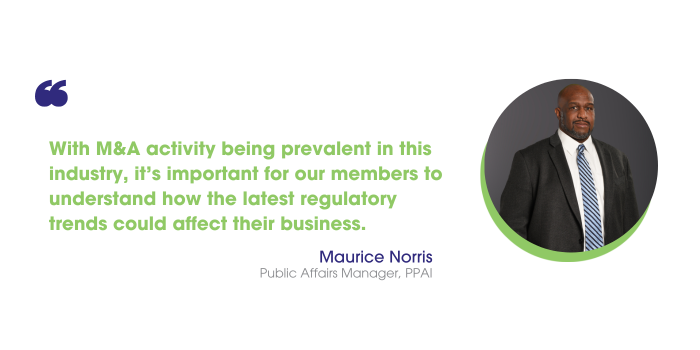Feds Bringing M&A Under Increased Scrutiny

Considering the consolidation of the promotional products industry over the past decade, and particularly since the COVID-19 pandemic, it’s important for promo leaders to understand the factors and frameworks that government agencies rely upon when analyzing mergers and acquisitions.
- At the end of last year, the Department of Justice and Federal Trade Commission released the 2023 Merger Guidelines, which breaks down their methodology behind reviewing M&A activity.
It’s one of the newest products from the Memorandum of Understanding between the DOJ and FTC published last September.

“With merger and acquisition activity being prevalent in this industry, it’s important for our members to understand how the latest regulatory trends could affect their business,” says Maurice Norris, PPAI’s public affairs manager. “These guidelines reveal a higher level of scrutiny in this space and outline the areas where the relevant federal agencies may direct their focus, which should help interested parties do their due diligence.”
M&A In Promo
M&A has been a major trend in promo over the past decade, as the largest suppliers and distributors have been gobbling up smaller – and even similar sized – competition to increase market share.
HPG – ranked the No. 8 supplier in the inaugural PPAI 100 – has been aggressively scooping up fellow suppliers, such as Evans Manufacturing, Handstands, Origaudio, Debco and Webb Company, which has rebranded to Mixie.
While HPG has been spearheading rampant M&A activity on the supplier side, HALO – ranked the No. 2 distributor in the PPAI 100 – has been a major catalyst for consolidation on the distributor side.
- The Sterling, Illinois-based juggernaut has welcomed several large distributors into the fold, such as Axis Promotions, Sunrise Identity and Caliendo Savio Enterprises (CSE).
- In 2022, San Jose, California-based distributor BrandVia joined the list of high-profile acquisitions by HALO.
Business service providers are also getting in the M&A game, with OrderMyGear making a huge splash in November by acquiring DistributorCentral, the Kansas-based technology provider for suppliers and distributors in the promotional products industry.
In the promo industry, most company acquisitions are actually asset purchases rather than the purchase of an actual corporate structure, according to Jamie Watson, MAS, COO of Huntertown, Indiana-headquartered Certified Marketing Consultants, which specializes in advising promo firms on M&A, private sales and business valuations.
“The largest asset for a distributor is almost always going to be the portfolio,” Watson told PPAI in March, “so in terms of purchasing a company, many times what we’re actually talking about is purchasing a portfolio. That probably accounts for 75% of the acquisitions within our industry.”
Guideline Changes
The 2023 Merger Guidelines have shrunk from 13 guidelines in the draft version to 11 in the finalized version.
- The proposed Guideline 13 warning of mergers that could “otherwise substantially lessen competition or tend to create a monopoly” has been replaced with an unnumbered caveat that the guidance “isn't exhaustive” of all the ways mergers can threaten competition.
- The proposed Guideline 6 has integrated into the finalized Guideline 5, which states that “the agencies will examine the extent to which a merger creates a risk that the merged firm will limit rivals’ access; gain or increase access to competitively sensitive information; or deter rivals from investing in the market.”
“These finalized Guidelines provide transparency into how the Justice Department is protecting the American people from the ways in which unlawful, anticompetitive practices manifest themselves in our modern economy,” says Attorney General Merrick B. Garland.
Market Share Thresholds
The 2023 Merger Guidelines, which are the culmination of a nearly two-year process, have kept lower thresholds for scrutinizing transactions. According to the finalized version, M&A activity is likely to be challenged if:
- a deal would give the combined firm a more than 30% market share;
- and if a deal reaches a lower concentration threshold than the one identified in the 2010 guidelines the new version replaces.
The 2010 version relies upon the Herfindahl-Hirschman Index (HHI), a commonly accepted measure of market concentration, according to the DOJ. In the new version, if a merger surpasses a score of 1,800 on the HHI (up from 2,500 in the 2010 version), it’s presumed to “substantially lessen competition or tend to create a monopoly.”
RELATED: ScreenBroidery’s M&A Strategy: Portfolios, Not Competitors
“Fair, open, competitive markets have been essential to America’s dynamic, thriving economy, and policing unlawful mergers is our front line of defense against harmful corporate consolidation,” says FTC Chair Lina M. Khan. “The 2023 Merger Guidelines reflect the new realities of how firms do business in the modern economy and ensure fidelity to statutory text and precedent.”
HSR Act Updates
In addition to updating merger guidelines, the FTC is also finalizing amendments to the Hart‑Scott‑Rodino (HSR) Antitrust Improvements Act of 1976 (aka the HSR Act).
- The HSR Act requires companies to file pre-merger notifications with the FTC and the Antitrust Division of the DOJ for certain acquisitions.
The amendments will require parties to provide significantly more information about their respective business operations, the markets where they operate and the companies against which they compete.
- The FTC estimates that 45% of HSR filings would require an additional 222 hours to prepare and 55% may require an additional 12 hours.

